Analog Soul, Digital Heart: The Engineering Behind the Sony STR-DH190
Update on Nov. 19, 2025, 4:45 p.m.
In an era dominated by compressed audio and wireless earbuds, the Sony STR-DH190 stands as a defiant monument to the golden age of high-fidelity. It is a classic 2-channel stereo receiver, a device category that many assumed would vanish. Yet, it remains a best-seller. Why?
The answer lies not in nostalgia, but in physics. By eschewing the complex video processing boards of modern AV receivers, the STR-DH190 focuses its entire engineering budget on one thing: Signal Integrity. Let’s open the chassis and explore the electrical engineering that makes this budget receiver a legitimate audiophile entry point.

The Physics of Phono: RIAA Equalization Explained
The headline feature for many buyers is the “Phono Input.” But to understand its value, we must understand the physics of a vinyl record.
When a record is cut, bass frequencies are physically reduced (attenuated) to prevent the needle from jumping out of the groove, while treble frequencies are boosted to overcome surface noise. This creates the RIAA Equalization Curve. * The Preamp’s Job: A standard “Aux” input expects a flat frequency response. If you plug a turntable directly into it, the music sounds tinny and hollow. The STR-DH190’s built-in Phono stage applies an inverse RIAA curve, boosting the bass by +20dB and cutting the treble. * Signal Amplification: A moving magnet (MM) cartridge outputs a tiny signal, often around 2.5mV to 5mV. The Phono stage must amplify this by roughly 100x to match the line-level inputs (CD, Streamer) without introducing noise. The STR-DH190 uses discrete components in this stage to maintain a high Signal-to-Noise Ratio (SNR), ensuring the quiet passages of your jazz records remain silent, not filled with static hiss.
Amplifier Topology: Class AB Efficiency
At its core, the STR-DH190 is a Class AB Amplifier. * Class A amplifiers conduct current 100% of the time, offering low distortion but terrible efficiency (lots of heat). * Class B amplifiers switch between two transistors (push-pull), offering high efficiency but suffering from “crossover distortion” where the signal hands off.
Class AB is the engineering compromise. It biases the transistors so they conduct slightly more than 50% of the cycle, eliminating crossover distortion while maintaining reasonable efficiency. The STR-DH190’s large power transformer and heat sink layout are designed to manage the thermal load of generating 100 Watts per channel (8 ohms). This discrete power stage provides the “headroom” needed for dynamic peaks—like a sudden drum hit—that lesser Class D chip-amps often compress.

Impedance Matching: The 6-16 Ohm Rule
One of the most misunderstood specs is speaker impedance. The STR-DH190 is rated for 6-16 ohms. * Ohm’s Law ($I = V/R$): As impedance (Resistance, roughly) drops, the current drawn from the amplifier increases. A 4-ohm speaker demands twice the current of an 8-ohm speaker for the same voltage. * The Risk: Connecting 4-ohm speakers to this receiver can cause it to overheat or trigger its protection circuit because the power supply isn’t built to sustain that level of current draw. * A+B Switching: The receiver allows you to connect two pairs of speakers (A and B). However, physics dictates that running A+B simultaneously connects them in parallel. If you run two pairs of 8-ohm speakers, the amplifier sees a 4-ohm load. This is safe. But running two pairs of 6-ohm speakers results in a 3-ohm load, which is dangerous for the amp. Understanding this ensures you don’t fry your new gear.
Pure Direct: The Shortest Signal Path
For the purist, the “Pure Direct” button is more than a preset; it’s a circuit bypass.
In normal operation, the audio signal passes through tone control circuits (Bass/Treble) and balance adjustments. Each component the signal traverses adds a tiny amount of noise and phase distortion.
Engaging “Pure Direct” physically routes the signal around these circuits, sending it straight from the volume control to the power amplifier. This reduces the noise floor, revealing micro-details in the recording—the breath of a vocalist or the decay of a piano note—that might otherwise be masked.
Bluetooth and the Digital Handshake
While analog is the soul, Bluetooth is the convenience. The STR-DH190 supports Bluetooth Standby, allowing you to wake the unit simply by connecting your phone.
Crucially, it supports the AAC codec (Advanced Audio Coding) alongside the standard SBC. For iPhone users, AAC provides a much higher quality wireless stream than SBC, offering better spectral efficiency and less compression artifacting. While it won’t match a wired CD connection, it ensures your Spotify or Apple Music streams sound crisp and engaging.

Conclusion: The Engineering of Value
The Sony STR-DH190 is not “cheap”; it is efficient. By stripping away video processing, Wi-Fi, and surround sound decoders, Sony allocates every dollar to the components that make music sound good: a beefy transformer, a discrete Class AB amplifier stage, and a proper RIAA phono preamp.
It represents the triumph of focused engineering over feature bloat. For the listener who wants to close their eyes and see the band, this black box provides the transparent window you need.



















